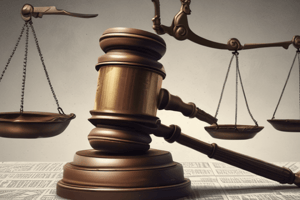Podcast
Questions and Answers
What is the primary characteristic of non-insane automatism?
What is the primary characteristic of non-insane automatism?
- It leads to partial acquittal.
- It presents a recurring danger.
- It involves a mental disorder.
- It is linked to external factors. (correct)
If a judge accepts the defense of non-insane automatism, what is the likely outcome?
If a judge accepts the defense of non-insane automatism, what is the likely outcome?
- No contest plea.
- Guilty with probation.
- Sent to psychiatric evaluation.
- Complete acquittal. (correct)
What is insane automatism characterized by?
What is insane automatism characterized by?
- Episodic behavioral changes.
- A disease of the mind. (correct)
- Temporary mental incapacity.
- External physical factors.
Who bears the burden of proof when raising an NCR defense?
Who bears the burden of proof when raising an NCR defense?
What is the primary concern addressed in a fitness to stand trial hearing?
What is the primary concern addressed in a fitness to stand trial hearing?
What can happen if an accused individual is found unfit to stand trial?
What can happen if an accused individual is found unfit to stand trial?
What happens if the accused is found NCR due to a disease of the mind?
What happens if the accused is found NCR due to a disease of the mind?
Which of the following statements regarding non-insane automatism is correct?
Which of the following statements regarding non-insane automatism is correct?
Intoxication can be used as a defence for which type of offence?
Intoxication can be used as a defence for which type of offence?
What might a person found not guilty of murder due to intoxication still be guilty of?
What might a person found not guilty of murder due to intoxication still be guilty of?
How does S. 33.1 of the Criminal Code affect the defence of intoxication?
How does S. 33.1 of the Criminal Code affect the defence of intoxication?
Why did Justice Sopinka argue that intoxicated individuals should face consequences?
Why did Justice Sopinka argue that intoxicated individuals should face consequences?
What is a key feature of the Carter or Two-Beer Defence?
What is a key feature of the Carter or Two-Beer Defence?
Following the 2008 Criminal Code Amendments, what evidence cannot be introduced unless certain conditions are met?
Following the 2008 Criminal Code Amendments, what evidence cannot be introduced unless certain conditions are met?
In the case of R.v. Lavallee, what significant change occurred in the law regarding self-defence?
In the case of R.v. Lavallee, what significant change occurred in the law regarding self-defence?
What did the defence experts conclude in R.v. Graveline regarding the state of the accused?
What did the defence experts conclude in R.v. Graveline regarding the state of the accused?
Why was the Crown's argument critical in R.v. Graveline regarding the timeline of events?
Why was the Crown's argument critical in R.v. Graveline regarding the timeline of events?
In the context of counselling to commit murder, what does S. 22(3) define as counselling?
In the context of counselling to commit murder, what does S. 22(3) define as counselling?
Why was Doucet's argument of duress preferred over Battered Woman Syndrome?
Why was Doucet's argument of duress preferred over Battered Woman Syndrome?
What role does an intervenor play in a legal case?
What role does an intervenor play in a legal case?
Why might the Canadian Association of Elizabeth Fry Societies intervene in a case?
Why might the Canadian Association of Elizabeth Fry Societies intervene in a case?
What did the Supreme Court decide after allowing the Crown's appeal?
What did the Supreme Court decide after allowing the Crown's appeal?
Flashcards
What is automatism?
What is automatism?
Automatic functioning without conscious effort or control.
What is non-insane automatism?
What is non-insane automatism?
Automatic behavior not caused by a mental disorder. It is triggered by external factors like sleepwalking or physical trauma.
What is temporary insanity?
What is temporary insanity?
Another name for non-insane automatism. It describes a temporary loss of control due to external factors.
Who has the burden of proof in non-insane automatism?
Who has the burden of proof in non-insane automatism?
Signup and view all the flashcards
What is insane automatism?
What is insane automatism?
Signup and view all the flashcards
What is NCR?
What is NCR?
Signup and view all the flashcards
What does NCR mean?
What does NCR mean?
Signup and view all the flashcards
What happens if an NCR defence is raised?
What happens if an NCR defence is raised?
Signup and view all the flashcards
Intoxication Defence
Intoxication Defence
Signup and view all the flashcards
Daviault Case
Daviault Case
Signup and view all the flashcards
S. 33.1 of the Criminal Code
S. 33.1 of the Criminal Code
Signup and view all the flashcards
Carter Defence
Carter Defence
Signup and view all the flashcards
2008 Criminal Code Amendments
2008 Criminal Code Amendments
Signup and view all the flashcards
Battered Woman Syndrome
Battered Woman Syndrome
Signup and view all the flashcards
R. v. Lavallee
R. v. Lavallee
Signup and view all the flashcards
Non-Insane Automatism
Non-Insane Automatism
Signup and view all the flashcards
R. v. Graveline
R. v. Graveline
Signup and view all the flashcards
R. v. Ryan
R. v. Ryan
Signup and view all the flashcards
Counselling to Commit Murder
Counselling to Commit Murder
Signup and view all the flashcards
Intervener
Intervener
Signup and view all the flashcards
Doucet's Duress Defence
Doucet's Duress Defence
Signup and view all the flashcards
Staying Proceedings
Staying Proceedings
Signup and view all the flashcards
Study Notes
Automatism
- Definition: Automatism is unconscious or involuntary action without conscious control.
- Non-Insane Automatism: Caused by external factors like physical blows, ailments (e.g., stroke, low blood sugar), or severe psychological trauma.
- Doesn't present a recurring risk.
- Sometimes called temporary insanity.
- Accused bears the burden of proof, requiring significant evidence.
- Complete acquittal if accepted by the judge.
- Insane Automatism: Caused by a disease of the mind.
- Presents a recurring risk.
- Called "Not Criminally Responsible" (NCR) in the Criminal Code.
- Criteria: mental disorder at the time of the crime, impairing the ability to understand the act's nature or wrongfulness.
- Burden of proof rests on the party raising the defence (either accused or Crown).
- Courts initially determine fitness to stand trial.
- Three questions of fitness:
- Understanding of proceedings.
- Understanding of consequences.
- Ability to communicate with counsel.
- Unfit accused is remanded to a psychiatric facility pending fitness.
- Verdict: Not Criminally Responsible (NCR).
- Sentences can include discharge (if no significant public risk), or psychiatric treatment (if public safety concern) and annual review.
Intoxication
- General Intent Offences: Intoxication is not a defence.
- Specific Intent Offences: Intoxication may be a defence.
- Aggravated assault: Is considered a general intent offence.
- R. v. Daviault: Extreme intoxication negated the necessary intent for sexual assault.
- Pharmacologist's testimony:
-Possible blackout due to 7-8 beers and a litre of brandy.
- Impaired brain function due to loss of reality contact.
- S. 33.1 Criminal Code: Drunkenness is not a defence for general intent offences (altered the Daviault outcome.)
- Justice Sopinka's Minority Opinion: Intoxication is the responsibility of the offender as per societal norms.
Carter or Two-Beer Defense
- Carter Defense: Challenging a breathalyzer test with evidence on drinking amounts and expert estimations of corresponding blood-alcohol levels.
- 2008 Code Amendments:
- Eliminated the ability to challenge breathalyzer results by introducing evidence of drinking amounts.
- Exception: machine malfunction or improper operation.
Battered Woman Syndrome
-
R. v. Lavallee: Battered Woman Syndrome became a legal defence allowing the accused to use self defence, even if the threat wasn't imminent.
-
R. v. Graveline: Non-insane automatism used due to absence of imminent threat (as opposed to self-defence).
-
Crown in Graveline: Argued automatism occurred after the act, not before.
-
R. v. Ryan: Doucet's actions (counselling for murder) were deemed "soliciting."
Duress
- Doucet chose duress and not battered woman syndrome/self-defense due to lack of imminent threat.
Stay of Proceedings (Doucet)
- The Court chose a stay of proceedings, and not conviction/acquittal. Thus, a legal finding wouldn't be recorded.
Studying That Suits You
Use AI to generate personalized quizzes and flashcards to suit your learning preferences.




